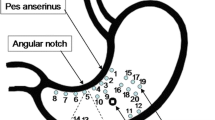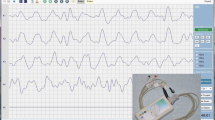Abstract
Gastric electrical uncoupling is the lack ofelectrical synchronization in different parts of thestomach. The aim of this study was to investigate theimpact of gastric electrical uncoupling on the level of randomness of canine electrogastrograms(EGG). Electrogastrograms were obtained from 11unconscious acute dogs. Gastric electrical uncouplingwas produced surgically by performing two consecutivecircumferential cuts through the entire thickness of thegastric muscle layer. Three separate 1/2-hreight-channel bipolar EGGs were obtained from each dogin the basal state and after each cut. The signals wereamplified using amplifiers with a flexible frequencyrange, digitized with 10-Hz sampling frequency, and4.27-min portions of the digital EGGs weResubjected toa turning point test for randomness. The number of turning points (NTPs) was determined fromsuccessive time intervals calculated from all EGGchannels. Distributions of NTPs were calculated for eachdog. An average NTPs (ANTP) for each dog in a givenstate (basal, after the first cut, and after thesecond cut) was calculated from the ANTPs of allchannels. In six of 11 dogs the ANTP were greater afterthe first cut. The number rose to nine of 11 dogs after the second cut. In only 45% of the dogs werethe ANTP distributions significantly different (P <0.01) after the first cut (sensitivity 45%). After thesecond cut the sensitivity rose to 64%. In two specific EGG channels NTP distribution wassignificantly different (P < 0.01) in nine of 11 dogs(sensitivity: 82% ) after the second cut. The dynamicsof the level of randomness in EGG can be indicative of severe gastric electrical uncoupling. SomeEGG channel configurations are moResensitive thanoThers in recognizing gastric electricaluncoupling.
Similar content being viewed by others
REFERENCES
Horrowitz M. Dent J, Fraser R., Sun W, Hebbard G: Role and integration of mechanism controlling gastric emptying. Dig Dis Sci 39:7S-13S, 1994
Camillieri M, PraTher CM: Axial forces during gastric emptying in health and models of disease. Dig Dis Sci 39:14S-17S, 1994
Keith K: Gastric emptying of liquids and solids: Roles of proximal and distal stomach. Am J Physiol 239:G71-G76, 1980
Dent J, Sun WM, Anvari M: Modulation of pumping function of gastric body and antropyloric contractions. Dig Dis Sci 39:28S-31S, 1994
Danie l E, Tougas G, Allescher HD, Vergara P, Fox-Threlkeld JA: Mediators and enteric nerve pathways controlling gastric emptying. Dig Dis Sci 39:63S-68S, 1994
Sarna SK, Daniel E: Vagal control of gastric electrical control activity and motility. Gastroenterology 68:301-308, 1975
Bedi BS, Kelly KA, Holley KE: Pathways of propagation of the canine gastric pacesetter potential. Gastroenterology 63:288-296, 1972
Bauer AJ, Publicover NG, Sanders KM: Origin and spread of slow waves in canine gastric antral circular muscle. Am J Physiol 249:G800-G806, 1985
Holle GE, Steinbach E, Forth W: Intrinsic corporoantropyloric coordination of motility and gastric emptying. Am J Physiol 266:G255-G262, 1994
Chen J, Vanddewalle J, Sansen W, Van Cutsem E, Vantrappen G, Janssens J: Observation of the propagation direction of human electrogastric activity from cutaneous recordings. Med Biol Eng Comput 27:538-542, 1989
Mintchev MP, Kingma YJ, and Bowes KL: Accuracy of cutaneous recordings of gastric electrical activity. Gastroenterology 104:1273-1280, 1993
Mintchev MP, Bowes KL: Extracting quantitative information from cutaneous electrogastrograms. Med Biol Eng Comput 34:244-48, 1996
Familoni BO, Kingma YJ, Bowes KL: Study of transcutaneous and intramural measurement of gastric electrical activity in humans. Med Biol Eng Comput 25:397-402, 1987
Mintchev MP, Otto SJ, Bowes KL: Electrogastrography can recognize gastric electrical uncoupling in dogs. Gastroenterology 112:2006-2011, 1997
Bracewell RN: The Hartley Transform. New York, Oxford University Press, 1986
Challis RE, Kitney RI: Biomedical signal processing. Part 1: Time-domain methods. Med Biol Eng Comput 28:509-524, 1990
Kendall, Sir M: Time Series, 2nd ed. Charles Griffin, 1976
Snedecor GW, Cochran WG: Statistical Methods, 6th ed. Ames, Iowa, The Iowa State University Press, 1974
Mintchev MP, Stickel A, and Bowes KL: Computer analysis of the impact of level of randomness on the electrogastrogram. Dig Dis Sci 43(5):953-956, 1998
Rights and permissions
About this article
Cite this article
Sanmiguel, C.P., Mintchev, M.P. & Bowes, K.L. Dynamics of Level of Randomness of Electrogastrograms Can Be Indicative of Gastric Electrical Uncoupling in Dogs. Dig Dis Sci 44, 523–528 (1999). https://doi.org/10.1023/A:1026697021756
Issue Date:
DOI: https://doi.org/10.1023/A:1026697021756




